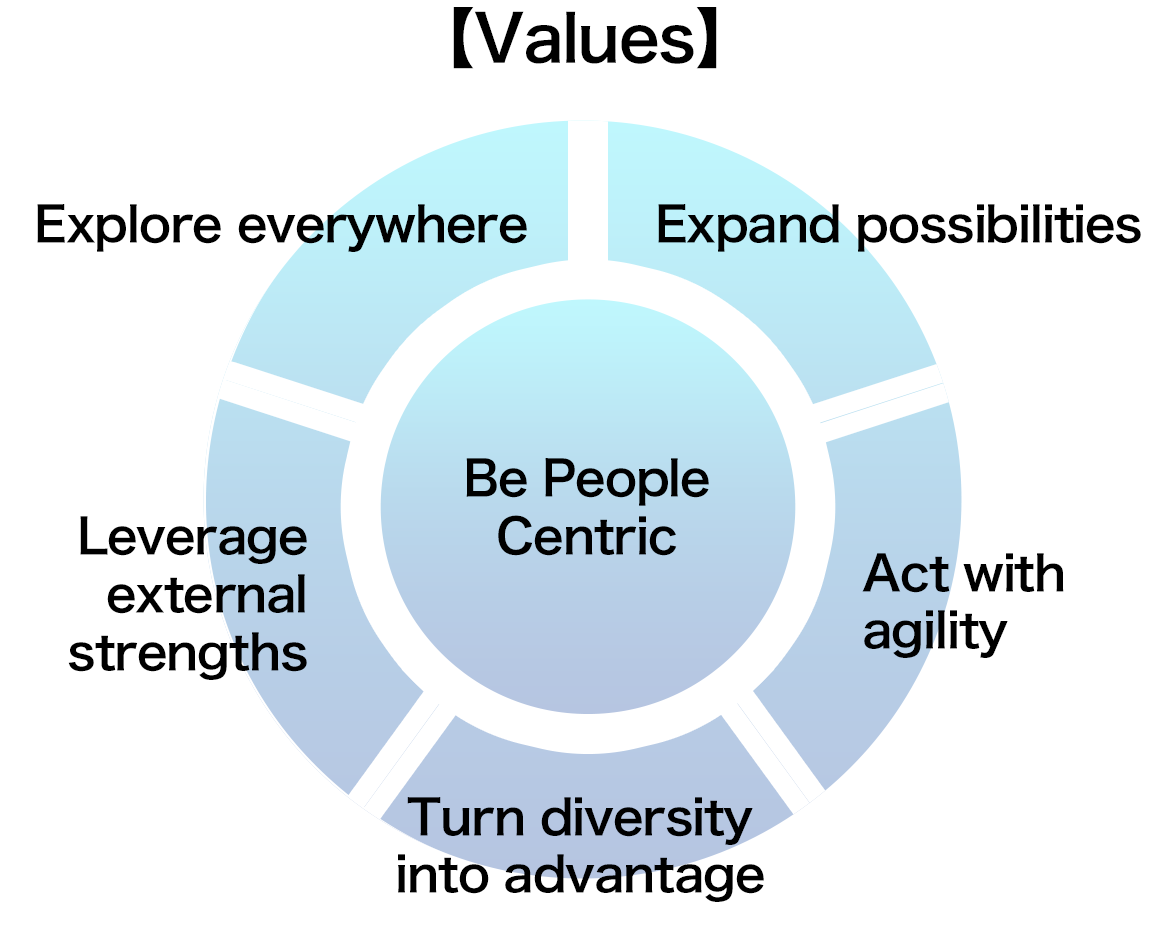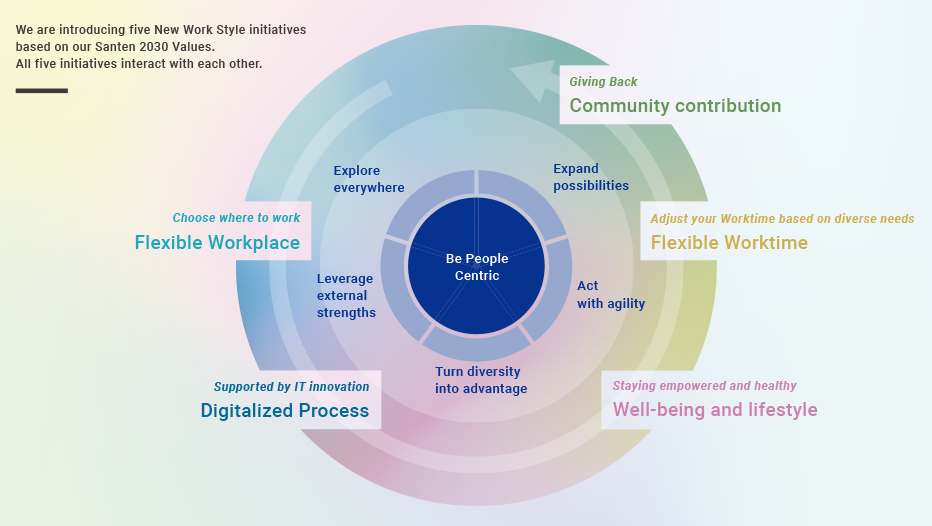Employee Growth and Organizational Culture
Santen recognizes importance of human capital, and makes efforts to equalize opportunities in recruitment, placement, promotion, and skill development, and will continue to cultivate, develop and promote human resources from a medium- to long-term perspective.
What Human Resources are We Looking for?
We established “Human Resources Development Guideline and Improvement of Organizational Environment Guideline” and in the guideline, we clarified the human resources we most seek.
The Human Resources We Most Seek
In order to realize Happiness with Vision,
- Human resources that always act “people-centric” and think about “people’s happiness”
- Human resources that are attentive to changes in environment surrounding ophthalmology and people’s needs, and think with a viewpoint considering all possibilities and Santenʼs unique strengths driving our strategy
- Human resources that co-create, continue to innovate and take on new challenges to solve problems globally
- Autonomous human resources who lead by example and strive for personal growth and career development to maximize the value of their contributions
Organizational and Human Resource Development Based on CORE PRINCIPLE
Santen's CORE PRINCIPLE "Tenki ni sanyo suru" underpins its efforts to create a strong organization and develop competent human resources too.
In FY2022, we revised our conduct assessment system into one based on our values, which define the values on which we place great importance toward the realization of our long-term vision and the principles on which we will focus during the next five to 10 years in particular. We therefore ensure that each employee's daily conduct will connect to the realization of our vision.

People Development through Management by Objectives
In Santen, all employees have a discussion with their manager at the beginning of the year to set goals after coordinating organizational and individual goals. Employees are evaluated based on their achievement of those goals at the end of the target period. To help employees achieve their goals, we provide opportunities for them to meet with their supervisors several times during the fiscal year review to discuss progress toward goals, as well as medium- to long-term career prospects. Conversations include past professional experiences, future career goals, and the opportunities and skills development necessary to achieve them. Employees may receive guidance and evaluations from supervisors in their matrix organization, as well as from immediate supervisors. Ultimately, evaluations reflect not only individual performance, but also organizational performance. We support each employee in improving and making the most of his or her abilities, which we hope will lead to a sense of accomplishment and growth at work.
People Development Program
We offer a variety of training programs, including new employee and position-specific training such as on medical representative (MR) education.
In Japan, we offer a self-development support system in which the company pays a portion of the costs of language and business skills training. We also cover a portion of test fees taken by employees as part of their self-development. To foster a sense of career autonomy in each employee, we provide expanded opportunities for dialogue between supervisors and subordinates in the workplace, meetings with outside career consultants.
Various training programs were held in each region in FY2023.
In EMEA, we held a learning festival that comprised 35 learning sessions led by employee instructors in their areas of expertise. Focused on four key themes – Know Yourself, Know Others, Know Our Business, and Knowledge in a Nutshell, the festival offered multiple courses and fostered a culture of collaboration and camaraderie. A total of 1,671 employees from EMEA and other regions participated in the program.
In China, we provided diversified learning programs to support the organizational development and cultivate learning culture. We developed programs focused on high-performing team, trust and collaboration, leadership development. Customized workshops were designed and delivered to business teams with related knowledge sharing on SNS. Practical management and leadership toolkits are also shared and utilized to improve the overall capabilities of our employees and people leaders.
In Asia, we developed a People Leaders Program which offers two tracks: championing employer experience for new managers and leading high performing teams for experienced leaders. The program focuses on practical applications of management and leadership theories through peer learning sessions and group sharing.
In addition to the above, in Asia and EMEA we started delivering development for our senior leaders, which includes 360 degree assessment, personalized coaching and leadership skills development training.
We disclose aggregated training data including above trainings in Social Data.
Improving Employee Engagement
Santen’s Listening framework integrates the voice of our people into data-driven business decisions, enhancing our team member’s engagement and commitment to Santen. Leveraging results from our listening exercises, we are continuously seeking to improve people-centric policies and practices.
Since 2022, we have conducted company-wide annual engagement surveys with Great Place to Work®, an independent research firm specializing in workplace culture. The survey covers aspects such as employees’ pride in their work, trust in working relationships, camaraderie, happiness, stress, and understanding of our CORE PRINCIPLE, vision and purpose. In parallel with the annual surveys, we regularly conduct ‘People Pulses’ to gather detailed employee feedback and sentiments on specific people policies and practices, such as our global Performance & Development (P&D) process.
The FY2023 survey results highlighted strengths in our employees’ pride in their work and alignment with Santen’s vision. Most of our employees expressed high engagement areas in their sense of pride about their individual contributions and team’s accomplishments. Aligned to this, the majority of our employees indicated their understanding of our CORE PRINCIPLE, vision and purpose.
We are carefully monitoring the trajectory of results and setting global and regional priority areas and relevant action items, such as communication and collaboration, to improve our team members’ engagement over time. Based on survey insights, we have been working on initiatives to improve communication effectiveness, promoting a two-way dialogue between managers and employees, and fostering collaboration in collective efforts. These initiatives include regular cadences of employee town halls and interactive information sessions at regional and functional employee groups. The second year of survey results indicated improvements in some countries and functions, which shows that local and team activities are yielding positive outcomes.
We disclose the result of the engagement survey.
Global Job Posting System
In April 2020, we have started operation of a new internal job posting system, the Global Job Posting System. This system is open to all employees of the Santen Group, and is open to all recruiting positions within the Group. Through the recruitment position, employees will be able to know what kind of career and growth opportunities they have, and by encouraging themselves to take up a medium- to long-term career, it will promote employees' growth.
Meister System
Since FY2017, Santen's Manufacturing Division has introduced the Meister System, an employee evaluation and treatment system uniquely employed in the Noto Plant and the Shiga Product Supply Center, Japan, with the aim of enhancing manufacturing operators' skills and motivation. Among the qualified candidates who have met the in-house criteria, the employees who have high levels of skills, achievements, experiences and trust from their subordinates, while performing "Individual Action Principles" that comprise CORE PRINCIPLE, are certified as Meisters.
Promotion of New Work Style
Due to the unprecedented challenges of the COVID-19 pandemic, we have been reimaging the future of work more seriously. Santen announced the "New Work Style" in May 2021 as a guideline to be shared with all its employees working around the world. To achieve further growth, it is pivotal for every single employee to realize the most suitable "way of working" so that we can leverage our potential as individuals and as a team.

The global guideline of New Work Style at the company is touching initiatives such as Flexible Workplace, Digitalized Processes, Well-being and lifestyle, Flexible Worktime as well as community contribution, all based on our values. For example, We adopted the concept of 'Digital Workplace' to accelerate the new way of working and are deploying IT infrastructure for all the members of the company can work comfortably from anywhere anytime. In addition to 'go paperless', digital signatures and streamlined online approval system, the company is expanding internal online communication tools so that we are able to be motivated and improve our productivity even working from home or elsewhere. Our employees have a choice of where, when and how to co-create our success through meaningful work and interactions to positively impact Happiness with Vision worldwide.
Employee Welfare and Benefit System
The company has introduced a wide variety of employee welfare and benefit systems, for example in Japan: asset-building support systems such as employee stock ownership and asset-building savings; systems to support employees in child or family care according to their life stage, including leave and shortened working hours; medical examinations on many items, which help employees continue to work in good shape; and survivor's pensions.
Supporting Employees in Preparing for Retirement
In Japan, the company offers retiring employees three options: using the reemployment system, receiving the job-hunting support service, or receiving financial aid for job training and job-hunting support after the period of reemployment. We also provide employees who are about to retire with career design training to allow them to understand reemployment, pension and other systems, as well as changes in the employment environment, and consider a life plan after retirement. We have thus established the employee support system to enable all employees to work for many years without worry.